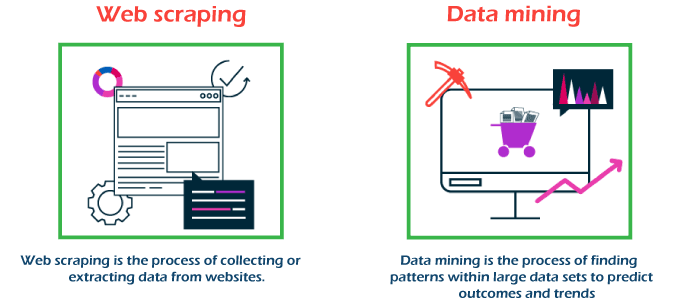Web Scraping vs Data MiningWeb scraping and data mining are two phrases often used in the same sentence. But while they share many similarities and use cases, they are fundamentally different from one another. Both concepts are gaining in popularity in online spaces. Whether it's a company publicizing their latest projects are individual users working on personal projects, web scraping and data mining are hot topics. Web scraping and data mining are sometimes confused with each other because they are both linked to extracting value from something valuable only when processed. However, the definitions are quite different, and not understanding the difference can cause not realize how these processes can create value for businesses. This article will clarify what each of these terms stands for and how web scraping is an enabler of data mining. We will introduce use cases that may apply to your business. What is Web Scraping?Web scraping is the method of collecting data from desired web pages and is also known as data collection and data extraction. With the Hypertext Transfer Protocol, Scraping tools and applications access the World Wide Web, gather valuable data, and extract it according to your needs. The information is stored in a central database or is downloaded for further use on your hard drive. Web scraping is the practice of extracting data directly from websites. Generally, web scraping has three main requirements; a target website, a web scraping tool, and a database to store harvested data. With web scraping, you're not limited to official data sources. Instead, you can use all publicly available data on websites and online platforms. You're web scraping if you browse a website and manually write down its contents. However, manual web scraping is incredibly time and energy-consuming. Not to mention, the front end of a website rarely has all publicly available data. Web scraping is used for many reasons, including financial and academic studies. A corporation or organization may use these strategies to gather data about its competitors and improve sales. Also, they play a critical role in creating leads online and attracting many customers. How does Web Scraping Work?With all the available data online, you'd need an insane amount to start creating something out of it, and human web scraping doesn't cut it. That's where specialized web scraping tools come into the role. They automatically read into a website's underlying HTML code. Although, some advanced scrapers could go as far as to include CSS and Javascript elements. It then reads and duplicates any unencrypted or prohibited data. A good web scraping tool can replicate the public content of an entire website. You can even instruct your web scraping tool only to collect a specific type of data from exporting into an Excel spreadsheet or CVS. What is Web Scraping used for?Data extracted via web scraping is often repurposed or used in live applications that require a continuous stream of data. Contact information can be ethically used as leads in marketing campaigns with the right permissions. The same applies to prices. If you were to create an app that compares specific products or services prices, you could offer a live comparison of prices from various websites by scraping their data. The most common live web scraping application is weather data. Most weather applications on Windows, Android, and Apple devices don't collect their own weather data. Instead, they import live data from credible weather forecast providers and implement them into their unique app UI. What is Data Mining?Web scraping is the act of harvesting data. The main focus is data and information that has value. With data mining, the goal is to create something new out of your data, even if it has little to no value, to begin with. Data mining derives information from raw data by analyzing it for trends and anomalies. You can get this type of data from a variety of sources. While you can scrape web pages for data mining, it's mostly done through online surveys, cookies, and public records collected by third-party individuals and institutions. How does Data Mining Work?There's no right or wrong way to mine data. You're doing data mining right as long as you credit your data sources and produce authentic results. Data mining doesn't focus on why or where you get your data as long as it's legal and credible. Getting data is the first step of five in data mining. Data scientists still need a proper location to store and work on their data as they segment it into related categories before they visualize it. Actual data mining is the process of mining data for information. You can do this simply using Excel spreadsheets or mathematical models to extract better info using coding languages such as Python, SQL, and R. What is Data Mining used for?While web scraping is mostly used for repurposing, data mining mainly focuses on creating value from data. Most projects that require data mining tend to fall under data science instead of technical projects. Data mining could be used for online marketing by collecting third-party data or mining your own business's data for insights. Data mining also has scientific and technical applications. For example, meteorologists mine massive amounts of weather data to forecast the weather accurately. How does Web Scraping Enable Data Mining?The essential connection between web scraping and data mining is data supply. Web scraping can create very rich data sources by collecting all the text and image content of many websites. Below are the top data types that web scraping enables for data mining applications:
Differences between Web Scraping and Data MiningThe difference between those two words should be pretty clear at this point. But let's see them in more clear terms. 
Next TopicData Wrangling
|
 For Videos Join Our Youtube Channel: Join Now
For Videos Join Our Youtube Channel: Join Now
Feedback
- Send your Feedback to [email protected]
Help Others, Please Share









